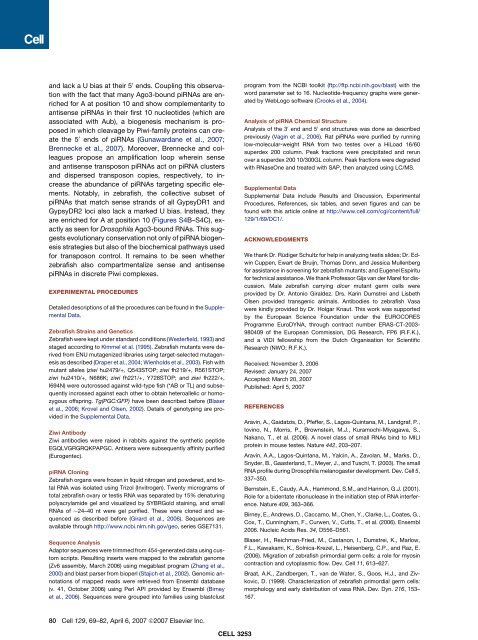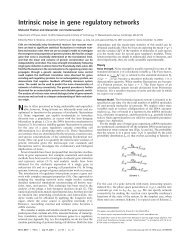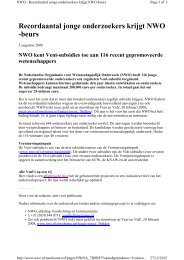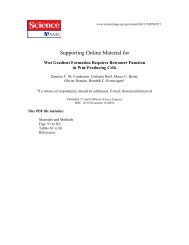A Role for Piwi and piRNAs in Germ Cell ... - Hubrecht Institute
A Role for Piwi and piRNAs in Germ Cell ... - Hubrecht Institute
A Role for Piwi and piRNAs in Germ Cell ... - Hubrecht Institute
Create successful ePaper yourself
Turn your PDF publications into a flip-book with our unique Google optimized e-Paper software.
<strong>and</strong> lack a U bias at their 5 0 ends. Coupl<strong>in</strong>g this observation<br />
with the fact that many Ago3-bound <strong>piRNAs</strong> are enriched<br />
<strong>for</strong> A at position 10 <strong>and</strong> show complementarity to<br />
antisense <strong>piRNAs</strong> <strong>in</strong> their first 10 nucleotides (which are<br />
associated with Aub), a biogenesis mechanism is proposed<br />
<strong>in</strong> which cleavage by <strong>Piwi</strong>-family prote<strong>in</strong>s can create<br />
the 5 0 ends of <strong>piRNAs</strong> (Gunawardane et al., 2007;<br />
Brennecke et al., 2007). Moreover, Brennecke <strong>and</strong> colleagues<br />
propose an amplification loop where<strong>in</strong> sense<br />
<strong>and</strong> antisense transposon <strong>piRNAs</strong> act on piRNA clusters<br />
<strong>and</strong> dispersed transposon copies, respectively, to <strong>in</strong>crease<br />
the abundance of <strong>piRNAs</strong> target<strong>in</strong>g specific elements.<br />
Notably, <strong>in</strong> zebrafish, the collective subset of<br />
<strong>piRNAs</strong> that match sense str<strong>and</strong>s of all GypsyDR1 <strong>and</strong><br />
GypsyDR2 loci also lack a marked U bias. Instead, they<br />
are enriched <strong>for</strong> A at position 10 (Figures S4B–S4C), exactly<br />
as seen <strong>for</strong> Drosophila Ago3-bound RNAs. This suggests<br />
evolutionary conservation not only of piRNA biogenesis<br />
strategies but also of the biochemical pathways used<br />
<strong>for</strong> transposon control. It rema<strong>in</strong>s to be seen whether<br />
zebrafish also compartmentalize sense <strong>and</strong> antisense<br />
<strong>piRNAs</strong> <strong>in</strong> discrete <strong>Piwi</strong> complexes.<br />
EXPERIMENTAL PROCEDURES<br />
Detailed descriptions of all the procedures can be found <strong>in</strong> the Supplemental<br />
Data.<br />
Zebrafish Stra<strong>in</strong>s <strong>and</strong> Genetics<br />
Zebrafish were kept under st<strong>and</strong>ard conditions (Westerfield, 1993) <strong>and</strong><br />
staged accord<strong>in</strong>g to Kimmel et al. (1995). Zebrafish mutants were derived<br />
from ENU mutagenized libraries us<strong>in</strong>g target-selected mutagenesis<br />
as described (Draper et al., 2004; Wienholds et al., 2003). Fish with<br />
mutant alleles (ziwi hu2479/+, Q543STOP; ziwi fh219/+, R561STOP;<br />
ziwi hu2410/+, N686K; ziwi fh221/+, Y728STOP; <strong>and</strong> ziwi fh222/+,<br />
I694N) were outcrossed aga<strong>in</strong>st wild-type fish (*AB or TL) <strong>and</strong> subsequently<br />
<strong>in</strong>crossed aga<strong>in</strong>st each other to obta<strong>in</strong> heteroallelic or homozygous<br />
offspr<strong>in</strong>g. Tg(PGC:GFP) have been described be<strong>for</strong>e (Blaser<br />
et al., 2006; Krovel <strong>and</strong> Olsen, 2002). Details of genotyp<strong>in</strong>g are provided<br />
<strong>in</strong> the Supplemental Data.<br />
Ziwi Antibody<br />
Ziwi antibodies were raised <strong>in</strong> rabbits aga<strong>in</strong>st the synthetic peptide<br />
EGQLVGRGRQKPAPGC. Antisera were subsequently aff<strong>in</strong>ity purified<br />
(Eurogentec).<br />
piRNA Clon<strong>in</strong>g<br />
Zebrafish organs were frozen <strong>in</strong> liquid nitrogen <strong>and</strong> powdered, <strong>and</strong> total<br />
RNA was isolated us<strong>in</strong>g Trizol (Invitrogen). Twenty micrograms of<br />
total zebrafish ovary or testis RNA was separated by 15% denatur<strong>in</strong>g<br />
polyacrylamide gel <strong>and</strong> visualized by SYBRGold sta<strong>in</strong><strong>in</strong>g, <strong>and</strong> small<br />
RNAs of 24–40 nt were gel purified. These were cloned <strong>and</strong> sequenced<br />
as described be<strong>for</strong>e (Girard et al., 2006). Sequences are<br />
available through http://www.ncbi.nlm.nih.gov/geo, series GSE7131.<br />
Sequence Analysis<br />
Adaptor sequences were trimmed from 454-generated data us<strong>in</strong>g custom<br />
scripts. Result<strong>in</strong>g <strong>in</strong>serts were mapped to the zebrafish genome<br />
(Zv6 assembly, March 2006) us<strong>in</strong>g megablast program (Zhang et al.,<br />
2000) <strong>and</strong> blast parser from bioperl (Stajich et al., 2002). Genomic annotations<br />
of mapped reads were retrieved from Ensembl database<br />
(v. 41, October 2006) us<strong>in</strong>g Perl API provided by Ensembl (Birney<br />
et al., 2006). Sequences were grouped <strong>in</strong>to families us<strong>in</strong>g blastclust<br />
80 <strong>Cell</strong> 129, 69–82, April 6, 2007 ª2007 Elsevier Inc.<br />
CELL 3253<br />
program from the NCBI toolkit (ftp://ftp.ncbi.nih.gov/blast) with the<br />
word parameter set to 16. Nucleotide-frequency graphs were generated<br />
by WebLogo software (Crooks et al., 2004).<br />
Analysis of piRNA Chemical Structure<br />
Analysis of the 3 0 end <strong>and</strong> 5 0 end structures was done as described<br />
previously (Vag<strong>in</strong> et al., 2006). Rat <strong>piRNAs</strong> were purified by runn<strong>in</strong>g<br />
low-molecular-weight RNA from two testes over a HiLoad 16/60<br />
superdex 200 column. Peak fractions were precipitated <strong>and</strong> rerun<br />
over a superdex 200 10/300GL column. Peak fractions were degraded<br />
with RNaseOne <strong>and</strong> treated with SAP, then analyzed us<strong>in</strong>g LC/MS.<br />
Supplemental Data<br />
Supplemental Data <strong>in</strong>clude Results <strong>and</strong> Discussion, Experimental<br />
Procedures, References, six tables, <strong>and</strong> seven figures <strong>and</strong> can be<br />
found with this article onl<strong>in</strong>e at http://www.cell.com/cgi/content/full/<br />
129/1/69/DC1/.<br />
ACKNOWLEDGMENTS<br />
We thank Dr. Rüdiger Schultz <strong>for</strong> help <strong>in</strong> analyz<strong>in</strong>g testis slides; Dr. Edw<strong>in</strong><br />
Cuppen, Ewart de Bruijn, Thomas Donn, <strong>and</strong> Jessica Mullenberg<br />
<strong>for</strong> assistance <strong>in</strong> screen<strong>in</strong>g <strong>for</strong> zebrafish mutants; <strong>and</strong> Eugenel Espiritu<br />
<strong>for</strong> technical assistance. We thank Professor Gijs van der Marel <strong>for</strong> discussion.<br />
Male zebrafish carry<strong>in</strong>g dicer mutant germ cells were<br />
provided by Dr. Antonio Giraldez. Drs. Kar<strong>in</strong> Dumstrei <strong>and</strong> Lisbeth<br />
Olsen provided transgenic animals. Antibodies to zebrafish Vasa<br />
were k<strong>in</strong>dly provided by Dr. Holgar Knaut. This work was supported<br />
by the European Science Foundation under the EUROCORES<br />
Programme EuroDYNA, through contract number ERAS-CT-2003-<br />
980409 of the European Commission, DG Research, FP6 (R.F.K.),<br />
<strong>and</strong> a VIDI fellowship from the Dutch Organisation <strong>for</strong> Scientific<br />
Research (NWO; R.F.K.).<br />
Received: November 3, 2006<br />
Revised: January 24, 2007<br />
Accepted: March 20, 2007<br />
Published: April 5, 2007<br />
REFERENCES<br />
Arav<strong>in</strong>, A., Gaidatzis, D., Pfeffer, S., Lagos-Qu<strong>in</strong>tana, M., L<strong>and</strong>graf, P.,<br />
Iov<strong>in</strong>o, N., Morris, P., Brownste<strong>in</strong>, M.J., Kuramochi-Miyagawa, S.,<br />
Nakano, T., et al. (2006). A novel class of small RNAs b<strong>in</strong>d to MILI<br />
prote<strong>in</strong> <strong>in</strong> mouse testes. Nature 442, 203–207.<br />
Arav<strong>in</strong>, A.A., Lagos-Qu<strong>in</strong>tana, M., Yalc<strong>in</strong>, A., Zavolan, M., Marks, D.,<br />
Snyder, B., Gaasterl<strong>and</strong>, T., Meyer, J., <strong>and</strong> Tuschl, T. (2003). The small<br />
RNA profile dur<strong>in</strong>g Drosophila melanogaster development. Dev. <strong>Cell</strong> 5,<br />
337–350.<br />
Bernste<strong>in</strong>, E., Caudy, A.A., Hammond, S.M., <strong>and</strong> Hannon, G.J. (2001).<br />
<strong>Role</strong> <strong>for</strong> a bidentate ribonuclease <strong>in</strong> the <strong>in</strong>itiation step of RNA <strong>in</strong>terference.<br />
Nature 409, 363–366.<br />
Birney, E., Andrews, D., Caccamo, M., Chen, Y., Clarke, L., Coates, G.,<br />
Cox, T., Cunn<strong>in</strong>gham, F., Curwen, V., Cutts, T., et al. (2006). Ensembl<br />
2006. Nucleic Acids Res. 34, D556–D561.<br />
Blaser, H., Reichman-Fried, M., Castanon, I., Dumstrei, K., Marlow,<br />
F.L., Kawakami, K., Solnica-Krezel, L., Heisenberg, C.P., <strong>and</strong> Raz, E.<br />
(2006). Migration of zebrafish primordial germ cells: a role <strong>for</strong> myos<strong>in</strong><br />
contraction <strong>and</strong> cytoplasmic flow. Dev. <strong>Cell</strong> 11, 613–627.<br />
Braat, A.K., Z<strong>and</strong>bergen, T., van de Water, S., Goos, H.J., <strong>and</strong> Zivkovic,<br />
D. (1999). Characterization of zebrafish primordial germ cells:<br />
morphology <strong>and</strong> early distribution of vasa RNA. Dev. Dyn. 216, 153–<br />
167.






